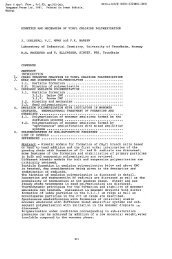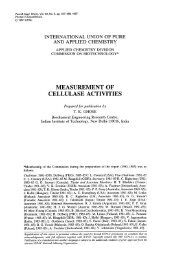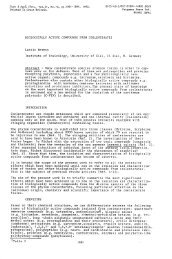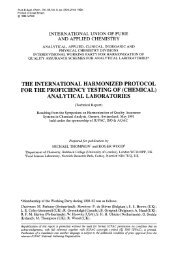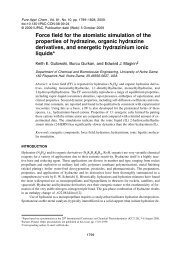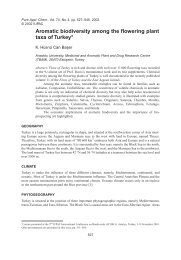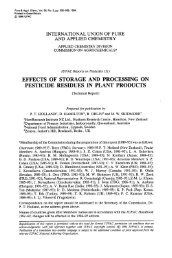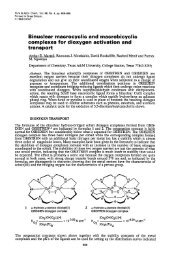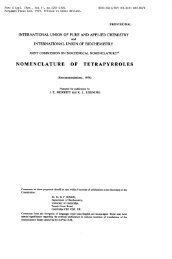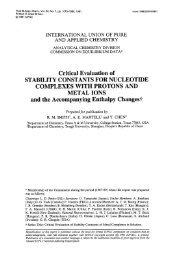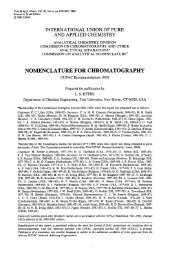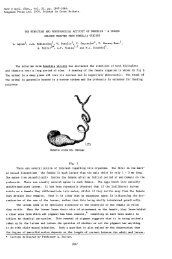Protolytic equilibrium in lyophilic nanosized dispersions ... - IUPAC
Protolytic equilibrium in lyophilic nanosized dispersions ... - IUPAC
Protolytic equilibrium in lyophilic nanosized dispersions ... - IUPAC
You also want an ePaper? Increase the reach of your titles
YUMPU automatically turns print PDFs into web optimized ePapers that Google loves.
1462<br />
N. O. MCHEDLOV-PETROSSYAN<br />
and related <strong>nanosized</strong> particles, <strong>in</strong>clud<strong>in</strong>g biomolecules [17g,19c–e,20]. Indicator dyes serve as useful<br />
tools for estimat<strong>in</strong>g the solubiliz<strong>in</strong>g ability [8a,21], microviscosity, and <strong>in</strong>terfacial polarity [18,22], for<br />
monitor<strong>in</strong>g local acidity and electrical potentials [5b,17d–f,h,18,19c,e,20,23], etc. Colored and fluorescent<br />
dyes embedded <strong>in</strong> organized solutions are widely used <strong>in</strong> sensor devices [24]. Fluoresc<strong>in</strong>g molecular<br />
probes are of particular significance for medical studies [19h]. Hydrophobic species can be absorbed<br />
with<strong>in</strong> the micellar core, [4a,8a,21,25]; <strong>in</strong> some papers, the (adsorption → ← absorption)<br />
<strong>equilibrium</strong> is discussed [4a,19c,21,26].<br />
Acid–base <strong>in</strong>dicators are generally believed to be located <strong>in</strong> the Stern region of ionic micelles<br />
[1b,17d,f,27]. As a rule, molar absorptivities of such dyes are of the order of magnitude of 10 5 dm –3<br />
mole cm –1 , hence the work<strong>in</strong>g concentrations can be 10 –5 M or even lower.* Typically, only a s<strong>in</strong>gle<br />
<strong>in</strong>dicator molecule (or ion) is situated <strong>in</strong> a micelle. Chart 1 shows a molecule of <strong>in</strong>dicator located <strong>in</strong> the<br />
palisade of a cationic surfactant micelle.<br />
Chart 1 A schematic picture of a fragment of a cationic micelle with an embedded <strong>in</strong>dicator.<br />
Naturally, the value of ∆pKm a = pKm a – pKw a can be expressed as a comb<strong>in</strong>ation of wγ m i values,<br />
analogous to eq. 3. However, s<strong>in</strong>ce the experimental determ<strong>in</strong>ation of pK m a is h<strong>in</strong>dered, it appeared more<br />
practical to discuss and analyze the so-called “apparent” value, pKa a , which is the key characteristic of<br />
an <strong>in</strong>dicator embedded <strong>in</strong> the micellar pseudophase.<br />
pK a a = pHw + log{[HBz ] t /[Bz–1 ] t } (7)<br />
The subscript t (total) denotes that the concentration is expressed <strong>in</strong> moles per dm3 of the whole<br />
solution. The pHw value characterizes the bulk phase and is determ<strong>in</strong>ed as a rule us<strong>in</strong>g a glass electrode<br />
<strong>in</strong> a cell with liquid junction.** The ratio of <strong>equilibrium</strong> concentrations of <strong>in</strong>dicator species can be obta<strong>in</strong>ed<br />
by means of UV/vis spectroscopy at extremely low <strong>in</strong>dicator concentrations.<br />
Hence, pK a a is an “<strong>in</strong>strumental” parameter which can be observed as a constant of two-phase<br />
<strong>equilibrium</strong>. In general, some fractions of Bz–1 and HBz species can stay <strong>in</strong> the bulk phase. To ensure<br />
*Hereafter, 1 M ≡ 1 mole dm –3 .<br />
**Some complications caused by the presence of a surfactant <strong>in</strong> the buffer system are considered <strong>in</strong> supplementary electronic<br />
material to a recent publication [29k].<br />
© 2008 <strong>IUPAC</strong>, Pure and Applied Chemistry 80, 1459–1510



